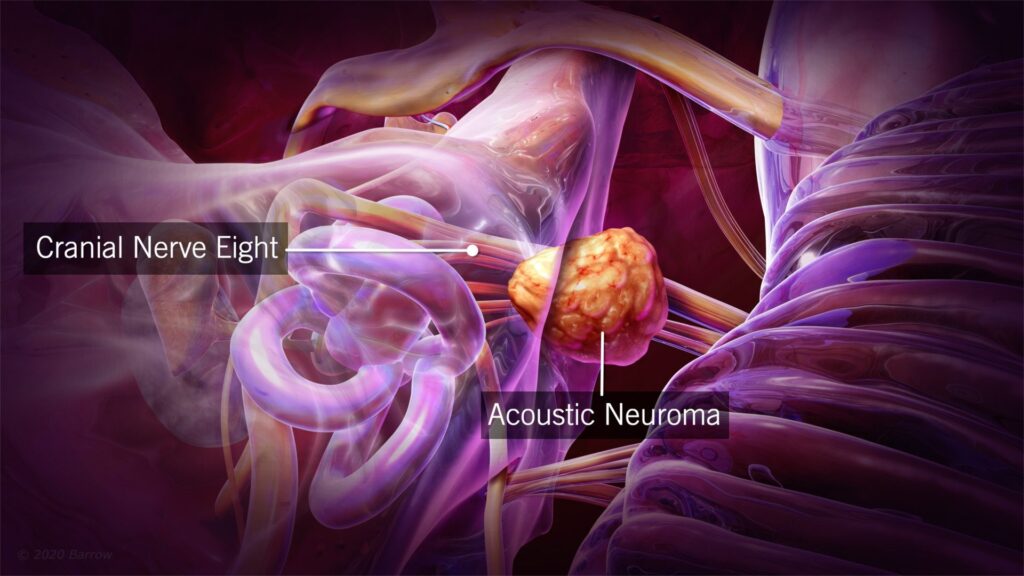What is an Acoustic Neuroma?
An Acoustic Neuroma, also known as a vestibular schwannoma, is a rare, non-cancerous (benign) tumour that develops on the vestibulocochlear nerve—the nerve responsible for transmitting sound and balance information from your inner ear to your brain. This tumour arises from Schwann cells, which normally insulate and support the nerve.

Despite the term “benign”, an acoustic neuroma can still cause serious health complications, especially if it grows large enough to press against adjacent structures in the brain. These tumours are typically slow-growing, but their location within the skull—confined and surrounded by vital nerves and the brainstem—means that even small tumours can lead to significant symptoms.
Where Does It Occur?
The vestibulocochlear nerve (also known as the eighth cranial nerve) has two main components:
-
The cochlear nerve, which is responsible for hearing
-
The vestibular nerve, which helps with balance
Acoustic neuromas usually begin on the vestibular portion, but as they grow, they can affect both hearing and balance, and may press on surrounding nerves, including the facial nerve (seventh cranial nerve), which controls muscles in the face and facial sensation.
How Common Is It?
Acoustic neuromas are rare, affecting around 1 to 2 people per 100,000 each year. They are most commonly diagnosed in adults aged 30 to 60, and while they can occur in anyone, they are slightly more common in women than in men.
In very rare cases, people may develop multiple acoustic neuromas due to a genetic condition called Neurofibromatosis type 2 (NF2), but most cases are isolated and sporadic.
What Are the Symptoms?
Symptoms can be mild at first and develop slowly, making early detection challenging. The most common signs include:
Hearing-Related Symptoms
-
Gradual hearing loss in one ear (unilateral hearing loss) – this is the most typical symptom and often the first noticeable sign.
-
Tinnitus – a constant or intermittent ringing, buzzing, or hissing sound in the affected ear.
-
A sensation of fullness in the ear – sometimes mistaken for earwax or a middle ear issue.
Balance and Coordination
-
Unsteadiness or imbalance – especially in low light or uneven terrain.
-
Vertigo (spinning sensation) – less common but may occur in some cases.
Neurological Symptoms
-
Facial numbness or tingling – due to pressure on the nearby facial nerve.
-
Weakness of facial muscles – in more advanced cases.
-
Headaches or pressure in the head – especially if the tumour is growing large and exerting pressure.
It’s important to note that symptoms can vary significantly. Some people live for years with no symptoms, while others may experience life-altering changes early on.
How Is an Acoustic Neuroma Diagnosed?
Because the symptoms often overlap with other more common ear-related conditions (like ear infections or age-related hearing loss), it can take time to reach a diagnosis.
The diagnostic process usually includes:
-
Hearing tests (audiometry): to detect hearing loss patterns typical of acoustic neuroma.
-
MRI (Magnetic Resonance Imaging): the gold standard for diagnosing and measuring the tumour. It shows the size, shape, and location with high detail.
-
Balance tests or vestibular assessments: may be used in some cases.
Is It Dangerous?
While acoustic neuromas are benign and do not spread to other parts of the body, they are not harmless. Their location within the skull—a space with limited room—means that growth can become dangerous if left untreated.
In rare cases, large tumours can press against the brainstem, which controls vital functions like breathing and heart rate. This can become life-threatening if not managed. More often, however, the concern is long-term damage to hearing, balance, and facial nerves, which can have a major impact on quality of life.
What Are the Treatment Options?
The best approach depends on several factors, including the tumour’s size, growth rate, the patient’s age and general health, and the presence of symptoms.
1. Watch and Wait (Active Monitoring)
For small tumours or those not currently causing symptoms, regular MRI scans (usually once a year or every 6 months) are used to monitor for any changes. Many acoustic neuromas grow slowly—or not at all—and may never require active treatment.
2. Stereotactic Radiosurgery (SRS)
This is a non-invasive treatment using targeted radiation beams (like Gamma Knife) to halt the growth of the tumour. It’s usually done in a single session and is most effective on small- to medium-sized tumours.
3. Surgical Removal
For larger tumours or those causing significant symptoms, surgery may be recommended. There are several surgical approaches depending on the tumour’s size and location, but risks include:
-
Permanent hearing loss in the affected ear
-
Facial nerve damage
-
Balance issues
Recovery can be lengthy, and surgery may be followed by physical therapy to help regain balance.
Living With an Acoustic Neuroma
Being diagnosed with an acoustic neuroma can feel overwhelming, especially if you’re experiencing ongoing symptoms like hearing loss or constant tinnitus. Even if you’re not undergoing active treatment, the emotional and psychological toll shouldn’t be underestimated.
Many people report feeling:
-
Isolated in social situations due to hearing difficulties
-
Anxious about tumour growth or future symptoms
-
Frustrated by the lack of public awareness about the condition
You’re not alone in this experience. Support groups and charities offer invaluable peer support, practical advice, and reassurance from others who truly understand.
Recommended Resources:
-
BANA UK (British Acoustic Neuroma Association): Offers resources, helplines, and events for people living with the condition.
-
British Acoustic Neuroma Support Group (Facebook): A welcoming online community to share experiences, ask questions, and find support.
-
Your audiologist or ENT specialist: can help with hearing aids or tinnitus management techniques.
Final Thoughts
Acoustic neuromas may be rare, but they can have a profound impact on day-to-day life. Understanding the condition is the first step in managing it, making informed decisions, and finding the support you need—whether you’re newly diagnosed, undergoing treatment, or navigating life with ongoing symptoms.
If you’re looking for personal stories, blog posts, or practical tips on living with an acoustic neuroma, feel free to explore more on this site—or get in touch.
